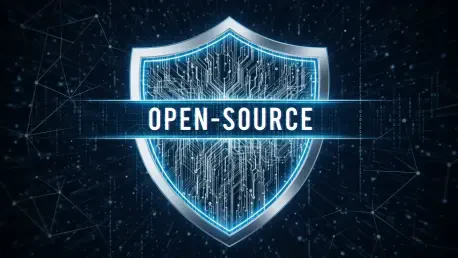Imagine a sprawling enterprise environment where thousands of applications power critical business operations, many built on open-source software for cost efficiency and flexibility, only to face a breach exploiting a known vulnerability in an outdated, unsupported open-source component that reached its end-of-life (EOL) years ago. The damage is severe—data leaks, downtime, and reputational loss follow. This scenario is not a distant possibility but a pressing reality for many organizations struggling to secure their software supply chains. This guide aims to help enterprise teams bridge security gaps in open-source components within a DevSecOps framework, offering actionable strategies to mitigate risks, especially for EOL software.
The purpose of this guide is to provide a clear, step-by-step approach to integrating security throughout the software development lifecycle (SDLC) while addressing the often-overlooked vulnerabilities in unsupported open-source tools. With the rapid adoption of DevSecOps principles, enterprises are embedding security earlier and monitoring it continuously, yet gaps remain when community support for open-source software ends. This resource is crucial for IT leaders, developers, and security professionals aiming to protect business-critical systems without disrupting operations or budgets.
The importance of addressing these gaps cannot be overstated. Open-source software forms the backbone of modern applications, but its fast-paced update cycles often leave enterprises with outdated components that lack patches for known vulnerabilities. By following this guide, organizations can strengthen their security posture, maintain compliance, and avoid the pitfalls of forced upgrades or unmitigated risks. The focus here is on practical solutions that align with existing DevSecOps practices, ensuring a seamless and sustainable approach to software security.
Understanding the Open-Source Security Challenge in DevSecOps
Open-source software, while a boon for innovation, introduces unique security challenges within the DevSecOps model, which seeks to integrate security at every stage of the SDLC. Enterprises rely heavily on these components for everything from web frameworks to database tools, yet many struggle to keep up with the pace of updates or handle the risks when support ends. This section explores why EOL open-source components pose a significant blind spot, even in robust DevSecOps environments.
The concept of “shifting left” encourages early security checks during development to catch issues before deployment, while “shifting right” emphasizes runtime monitoring and incident response in production. These strategies are vital for a proactive security stance, but they often fall short when dealing with unsupported software. Without community patches or updates, vulnerabilities in EOL components linger, exposing systems to exploitation despite the best DevSecOps efforts.
A broader approach is necessary to address these persistent risks. Enterprises must look beyond traditional tactics and consider how to manage the full lifecycle of open-source software, including periods after official support ceases. This guide lays the foundation for understanding these challenges and prepares readers to implement comprehensive solutions that protect against both current and legacy vulnerabilities.
Evolution of Security Practices in Enterprise Software Development
Application security has undergone a dramatic transformation over recent years, moving from a final pre-release hurdle to a continuous, developer-centric process. In the past, security was often an afterthought, applied just before launch, leaving little room for thorough remediation. Today, with the rise of DevSecOps, security is woven into every phase of the SDLC, from planning to production, ensuring issues are addressed promptly and efficiently.
This cultural and technical shift reflects a growing recognition of security as a shared responsibility among developers, operations, and security teams. Enterprises now prioritize tools and practices that enable real-time feedback, automated testing, and collaborative workflows. The result is a more resilient development pipeline, better equipped to handle the complexities of modern software ecosystems, including the pervasive use of open-source components.
The relevance of this evolution is particularly evident when managing open-source software in business-critical applications. As these components become integral to enterprise systems, the need for consistent security oversight grows. This historical context underscores the urgency of adapting DevSecOps practices to cover not just active development but also the long-term risks associated with aging software, setting the stage for targeted solutions.
Step-by-Step Guide to Bridging EOL Open-Source Risks in DevSecOps
Step 1: Recognizing the EOL Blind Spot in DevSecOps
The first step in securing open-source software is to acknowledge a critical oversight in many DevSecOps frameworks: the vulnerability of EOL components. These are pieces of software no longer supported by their communities, meaning no new patches or updates are available to address known flaws. Enterprises often lag behind the rapid update cycles of open-source projects, leaving systems exposed for extended periods.
Why EOL Software Becomes a Prime Target
Attackers frequently target EOL software because its vulnerabilities are well-documented and unmitigated. Without community support, there are no fixes to counter exploits, making these components low-hanging fruit for malicious actors. This risk is amplified in enterprise settings where such software often underpins critical infrastructure, increasing the potential impact of a breach.
The Constraints of Enterprise Upgrade Timelines
Upgrading to newer versions of software is not always a feasible option for enterprises due to operational and financial constraints. Large-scale systems require extensive planning, testing, and validation before changes can be implemented, often taking months or even years. During this delay, unsupported components remain vulnerable, highlighting the need for alternative security measures.
Step 2: Leveraging Shifting Left to Detect Early Risks
The second step involves adopting a “shift left” approach to identify risks early in the development process. By integrating security checks during coding and testing phases, teams can spot EOL dependencies or vulnerabilities before they reach production environments. This proactive stance reduces the likelihood of deploying flawed components.
Tools for Early Vulnerability Scanning
Various tools are available to assist in early detection, such as static application security testing (SAST) solutions and dependency scanners. These can flag outdated libraries or unsupported versions during code commits, providing developers with immediate insights. Incorporating such tools into continuous integration pipelines ensures consistent visibility into potential risks.
Limitations of Early Detection Without Fixes
While shifting left excels at identifying issues, it cannot resolve them when patches are unavailable for EOL software. Visibility alone does not equate to security; without actionable remediation, vulnerabilities persist. This limitation necessitates additional strategies to complement early detection efforts and address unresolved threats.
Step 3: Utilizing Shifting Right for Runtime Protection
The third step focuses on “shifting right,” which emphasizes securing production environments through continuous monitoring and response mechanisms. Even with EOL components in use, runtime protections can help detect and mitigate threats as they occur, providing a crucial layer of defense.
Monitoring for Exploitation Attempts
Runtime monitoring tools, including intrusion detection systems and anomaly detection platforms, play a vital role in spotting exploitation attempts. These solutions analyze system behavior and network traffic to identify suspicious activities linked to known vulnerabilities. Swift alerts enable teams to respond before significant damage occurs.
The Gap in Remediation Without Patches
Despite the effectiveness of runtime monitoring, a significant gap remains: the inability to remediate issues without available patches. Detecting an attack is only half the battle; without updates to fix underlying flaws, systems remain at risk of repeated exploitation. This challenge underscores the need for alternative remediation options.
Step 4: Integrating Extended Security Patching Services
The final step is to incorporate extended security patching services as a solution for EOL open-source components. These services provide backported fixes—security updates adapted for older versions—allowing enterprises to maintain protection without immediate upgrades. This approach fills the gap left by traditional DevSecOps tactics.
Benefits of Backported Security Fixes
Backported fixes offer ongoing protection against known vulnerabilities, extending the secure lifespan of critical software. They also support compliance requirements by providing documented evidence of security measures, a key consideration for regulated industries. This method ensures systems remain safeguarded without disrupting established workflows.
Aligning Extended Support with DevSecOps Goals
Extended patching aligns seamlessly with DevSecOps principles by ensuring security across the entire SDLC, including post-EOL phases. It complements shifting left and right by addressing the remediation gap, creating a cohesive security posture. Enterprises adopting this strategy can achieve true end-to-end protection, balancing innovation with risk management.
Key Takeaways for Securing Open-Source in Enterprises
- DevSecOps integrates security across the SDLC through shifting left and right, yet EOL software remains a persistent blind spot.
- EOL open-source components are vulnerable due to the absence of patches, creating risks despite early detection and runtime monitoring efforts.
- Extended security patching services bridge this gap by offering backported fixes, preventing the need for rushed or disruptive upgrades.
- True end-to-end security demands a combination of DevSecOps practices with lifecycle support for unsupported software components.
Looking Ahead at Open-Source Security Trends
The landscape of open-source security continues to evolve at a rapid pace, challenging enterprises to adapt their strategies accordingly. As development cycles accelerate, the gap between community updates and enterprise adoption is likely to widen, increasing exposure to EOL risks. Staying ahead requires a commitment to continuous improvement and vigilance in security practices.
Emerging technologies, such as automated patching systems and AI-driven risk assessment tools, hold promise for streamlining vulnerability management. These advancements could reduce manual effort and enhance precision in identifying and mitigating threats. Enterprises must monitor these trends to integrate cutting-edge solutions into their DevSecOps frameworks over time.
The growing complexity of software supply chains further emphasizes the need for adaptive measures. As dependencies multiply, so do potential points of failure, making comprehensive lifecycle support more critical than ever. Organizations that prioritize flexibility and foresight will be best positioned to navigate these challenges in the digital era.
Final Thoughts on Closing the Security Loop
Reflecting on the journey through this guide, the steps taken to address open-source security gaps within DevSecOps proved both practical and essential. From recognizing the risks of EOL software to implementing extended patching services, each phase built a stronger defense against vulnerabilities. The process highlighted the limitations of shifting left and right alone, paving the way for a more holistic approach.
Looking beyond these efforts, enterprises were encouraged to explore partnerships with specialized security providers for tailored patching solutions. Assessing current dependency inventories emerged as a vital next step, ensuring no unsupported component slipped through the cracks. These actions promised to sustain security over the long term.
Ultimately, the path forward rested on fostering a culture of persistent adaptation. By committing to regular audits and staying informed about evolving threats, organizations positioned themselves to preempt risks before they escalated. This proactive mindset transformed security from a static checkpoint into a dynamic, enduring safeguard.








